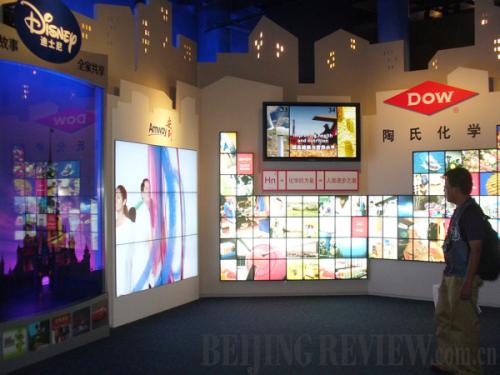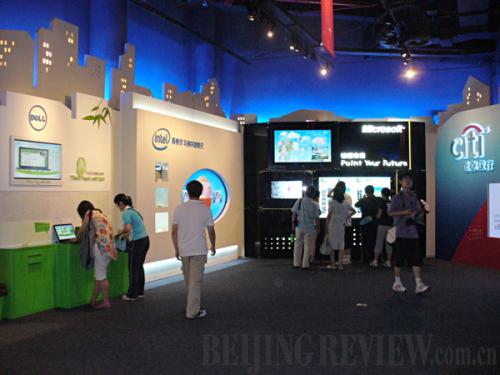|
 |
|
Inside the USA Pavilion (JENNIFER JETT) |
 |
|
Inside the USA Pavilion (JENNIFER JETT) |
Having read about the USA Pavilion before I visited the World Expo in Shanghai, I expected to be underwhelmed. But I was completely unprepared for what I saw.
It's no secret that the United States has stumbled throughout the Expo process, repeatedly missing deadlines. At one point, it appeared that the United States would have no presence in Shanghai at all. Secretary of State Hillary Clinton, recognizing how disastrous that would be for the China-U.S. relationship, finally stepped in and reiterated her support for U.S. participation.
American law prohibits the appropriation of funds for Expo pavilions without express authorization from Congress. Without public funding, organizers had to turn to the private sector to pay for the $61 million USA Pavilion – and those companies got their money's worth.
The USA Pavilion is divided into four rooms. Visitors who have lined up for an hour or more enter the lobby several hundred at a time. Inside, a young American host greets them in fluent Mandarin, with linguistic nods to visitors from Shanghai and other parts of China. Everyone proceeds to watch a short film in which adorably clueless Americans try to say "Ni hao" and "Dajia hao" with patient coaching from the film crew. Even Kobe Bryant and Tony Hawk make an appearance. Although it was cheesy, the film was a real crowd-pleaser and my national pride began to swell. Maybe this won't be so bad, I thought.
In the second room, visitors watch a second film. After messages from Clinton and President Barack Obama, the film alternates between interviews with children about their hopes and dreams and interviews with corporate spokespeople about how hopeful children are. The corporations represented in the film include General Electric, Chevron and PepsiCo – all sponsors, of course. This film left me a little confused, but I reserved judgment for the moment. We exited through doors emblazoned with familiar brand logos – Pepsi, Lays, Tropicana, Quaker Oats, Gatorade. All of them are PepsiCo products. On signs overhead, Pfizer thanked visitors for not smoking.
In the third room – the Citibank Theater – visitors watch yet another film. This one is about a little girl who enlists the help of her neighbors in turning a vacant lot into a community garden. It's a parable about ostensibly American traits such as optimism and perseverance, complete with 4-D rain and lightning effects. So far the main cultural message from the pavilion seemed to be that Americans like to watch TV.
If the first three rooms threw a few light commercial jabs, the fourth room was a knockout punch. Pavilion officials say this room is supposed to showcase American technologies and innovations in line with the Expo theme of "Better City, Better Life." What it actually does is give multinational corporations free advertising space. Each panel in the room sings the praises of a different pavilion sponsor.
"Motorola's Innovations Make Your Life Better," the first panel announces. Visitors can learn about Marriott's 83 years of hospitality. Wal-Mart touts its Direct Farm Program. Even a map titled "Cities and States of the USA" highlights only Hawaii, Texas, Tennessee, and the cities of Chicago, San Antonio and Houston – all USA Pavilion sponsors. Apparently other cities and states only exist if they're willing to put up some money.
It continues in the gift shop. Disney and Pepsi products are on prominent display. Signs at the cash registers encourage customers to "go with Visa." If you run out of cash, you can always use the Citibank ATM conveniently located by the door.
Corporate sponsorship is nothing to be ashamed of and the United States is far from the only country that used it. The difference is other pavilions recognized their sponsors tastefully. The Australia Pavilion, for example, has company logos on the wall for visitors to see as they exit the building. Other countries post signs in each room stating which company provided the funding. They don't give corporate sponsors free reign over pavilion content.
The USA Pavilion is especially disappointing considering how much thought and effort other countries put into theirs, often on much smaller budgets. Japan has violin-playing robots. Mexico has a beautiful art collection. The United States has a corporate shrine.
USA Pavilion Commissioner General Jose Villarreal promised that the pavilion would "showcase American values, ideas, and culture to an international audience eager for knowledge about the United States and the world." Unfortunately, those American values don't come through in this pavilion. Anyone who based their understanding of the United States on the USA Pavilion alone could only conclude that America is crass, materialistic, and spiritually empty. What a wasted opportunity.
The author is an American living in Beijing |